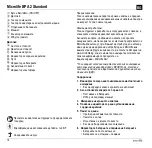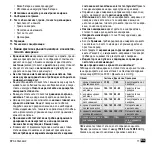
2
• Using rechargeable batteries
7. Using a Mains Adapter
8. Error Messages
9. Safety, Care, Accuracy Test and Disposal
• Safety and protection
• Device care
• Cleaning the cuff
• Accuracy test
• Disposal
10. Guarantee
11. Technical Specifications
1. Important Facts about Blood Pressure and Self-
Measurement
Blood pressure
is the pressure of the blood flowing in the
arteries generated by the pumping of the heart. Two values, the
systolic
(upper) value and the
diastolic
(lower) value, are
always measured.
The device indicates the
pulse rate
(the number of times the
heart beats in a minute).
Permanently high blood pressure values can damage your
health and must be treated by your doctor!
Always discuss your values with your doctor and tell him/her if
you have noticed anything unusual or feel unsure.
Never rely
on single blood pressure readings.
Enter your readings in the enclosed
blood pressure diary
.
This will give your doctor a quick overview.
There are many causes of excessively
high blood pressure
values
. Your doctor will explain them in more detail and offer treat-
ment where appropriate. Besides medication, relaxation techniques,
weight loss and exercise can also lower your blood pressure.
Under no circumstances should you alter the dosages of
drugs or initiate a treatment without consulting your doctor.
Depending on physical exertion and condition, blood pressure is
subject to wide fluctuations as the day progresses.
You should
therefore take your measurements in the same quiet condi-
tions and when you feel relaxed!
Take at least two measure-
ments per day, one in the morning and one in the evening.
It is quite normal for two measurements taken in quick succes-
sion to produce significantly
different results
.
Deviations
between measurements taken by your doctor or in
the pharmacy and those taken at home are quite normal, as
these situations are completely different.
Several measurements
provide a much clearer picture than
just one single measurement.
Leave a small break
of at least 15 seconds between two
measurements.
If you are
pregnant
, you should monitor your blood pressure
regularly as it can change drastically during this time.
If you suffer from an
irregular heartbeat
(arrhythmia, see
«Section 4.»), measurements taken with this device should only
be evaluated after consultation with your doctor.
The pulse display is not suitable for checking the
frequency of heart pacemakers!
How do I evaluate my blood pressure?
The higher value is the one that determines the evaluation. Example:
a readout value between
150/85
or
120/98
mmHg indicates «blood
pressure too high».
An index of 140/90 is shown adjacent to the traffic light bars
AP
. Your
blood pressure is too high if the bars reach or exceed this index.
Table for classifying blood pressure values in adults in accordance
with the World Health Organisation (WHO) in 2003. Data in mmHg.
Range
Systolic Diastolic Recommendation
blood pressure too low
100
60
Consult your
doctor
1. blood pressure
optimum
100 - 120 60 - 80
Self-check
2. blood pressure normal
120 - 130 80 - 85
Self-check
3. blood pressure slightly
high
130 - 140 85 - 90
Consult your
doctor
4. blood pressure too
high
140 - 160 90 - 100
Seek medical
advice
5. blood pressure far too
high
160 - 180 100 - 110
Seek medical
advice
6. blood pressure
dangerously high
180
110
Urgently seek
medical advice!
Summary of Contents for BP A2 Standard
Page 9: ...7 BP A2 Standard EN...
Page 14: ...12 1 9 3 3 ERR 1 ERR 2 ERR 3 ERR 5 HI 299 200 5 LO 40...
Page 17: ...15 BP A2 Standard RU...
Page 21: ...19 BP A2 Standard BG 5 30 8 M AO A 30 30 31 CL CL 1 M AO 8 6 AN a AN 1 5 2 4 1 5 V AA NiMH...
Page 23: ...21 BP A2 Standard BG 3 3 2 Microlife 10 1 2 3 4 Microlife...
Page 25: ...23 BP A2 Standard BG...



















